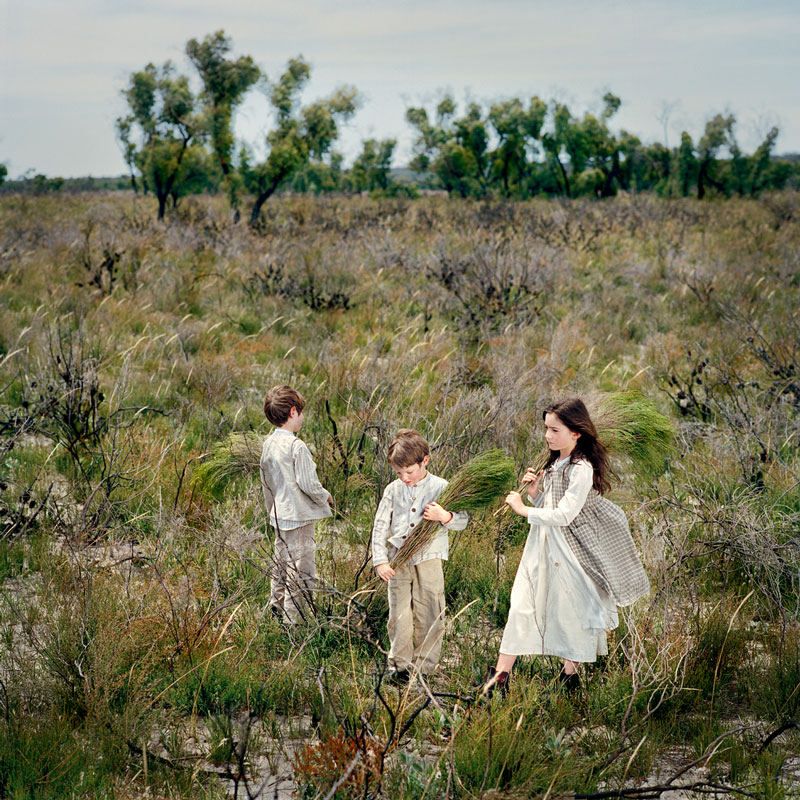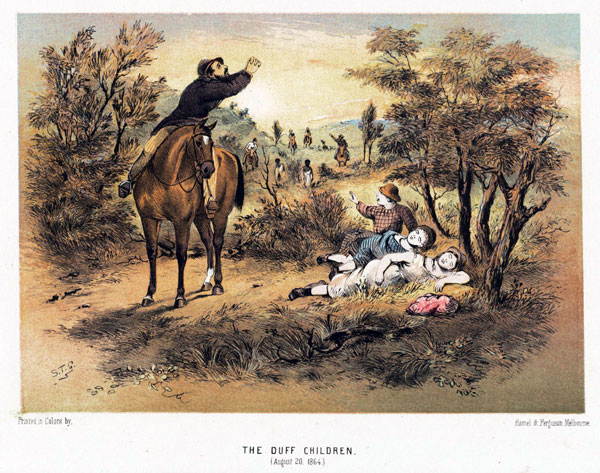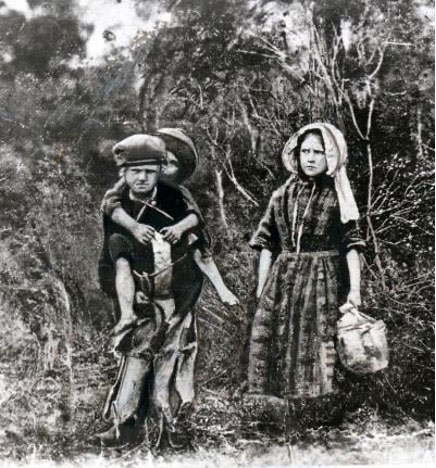|
Photographs we have collected and still own and some now in new homes elsewhere
The Wimmera 1864 # 1
Polixeni Papapetrou (1960–2018 )
Gael Newton AM, October 2025
 |
| The Wimmera 1864 #1 2006 |
The Wimmera 1864 # 1 is my favourite work from Polixeni Papapetrou’s twelve-part 2006 series Haunted Country which references historic and fictional accounts of lost or abducted children in Australia. Some of these were found alive, others perished. Some were killed. Papapetrou told how she had encountered lost children stories in her own childhood in Victoria and how in 2006 these stories had relevance for her as a mother of two children.
Eleven of the images were made on a series of excursions to sites in Victoria associated with famous lost children. Papapetrou undertook these excursions with husband Robert Nelson and their two children, nine year old Olympia and seven year old Solomon Nelson, together with some of their young friends. Both their children had participated as models in Papapetrou’s earlier studio-based tableaux series.
Papapetrou started staging scenes from fairy and fantasy tales in 2003 and in 2004 the Wonderland series. These were based on Lewis Carroll’s 1865 novel Alice in Wonderland as well as Carroll’s own photography of children that were rediscovered and frequently profiled in the 1980s-90s.1 The images in Haunted Country are titled by date and by place and most are single images. The titles are shorthand to head off obsession with the specifics of any particular story. Yarra Valley 1857 has four images and Daylesford 1867 has two images. The rest are single images: Whroo 1855, The Wimmera 1864, Keilor Plains 1895, Hanging Rock (from the fictional Joan Lindsay book Picnic at Hanging Rock set in 1900), Witness 1933 and She saw 2 girls and a boy (based on the three Beaumont children abducted at a beach in South Australia1966).2
Haunted Country is the first of Papapetrou’s tableaux to move outdoors. Most of the figures are set close against dense surrounding bush as in a shallow stage. Papapetrou does not show dead children and avoids melodrama. We see neither the terror that is to come nor the jubilation if found. Wimmera derives from the remarkable survival of the three Duff children, Isaac nine, Jane seven and four year old Frank from Spring Hill station between Goroke and Natimuk, some distance from Horsham.
The children lost their way in scrub at Nurcoung near Mt. Arapiles while collecting ti-tree branches in the surrounding Mallee country for their mother. With the help of an Aboriginal tracker, all three were found emaciated but alive after nine days and eight nights.3 Press reports focussed on Jean’s role in taking off her clothing to cover her brothers. She was acclaimed as hero and moral exemplar.4 Child heroes were a poplar evangelical motif in 19th century tracts. A side aspect of the press stories was the role of ‘King Richard’ or ‘Dick-a-Dick’, the tracker who found the Duff children.
Curiously given the public interest, a photographer did not secure portraits of the Duff children or the rescuers. However artists such S.T. Gill quickly provided illustrations. Nicholas Chevalier’s engraving appeared in the Illustrated Melbourne Post 22nd September 1864. In 1876 William Strutt began an illustrated story Cooey – or - The Trackers of Glenferry. It was not completed till 1901 or published until 1989.
 |
| Samuel Thomas Gill, 1818-1880 - The Duff children, August 20, 1864 |
 |
The Duff children, from the School Paper, 1908.
Argus Collection, General Series, Box 7. La Trobe Picture Collection. |
Photographic tableaux were re-enacted in 1908 for a School paper. There have been a few early re-enactments in photographs of the Duff and Daylesford children and as seen above the scenario doesn’t quite come off yet the images have their appeal.
At first glance Wimmera 1864 #1 has the look of the type of 19th century rustic scenes of workers in fields or a Heidelberg school pastorale.
The intention of the former was most often about the productivity and pleasures of the land occasionally about social inequality. Heidelberg painters largely celebrated a growing settler society's sense of being at home in and appreciating the beauty of the Australian landscape.
Papapetrou's Wimmera is set in the open Mallee wood and wet lands unsuitable for agriculture. In the foreground the three children are gathering bundles of ti-tree branches. It is a fine cool day. The scene is rich in subtle tones and pattern. The children’s simple clothes are old fashioned and have the soft fawn and beige colours of their surrounds. A breeze seems to bend the grasses as well as blow the hair and wrap the clothes round the youngsters. In the background the multi-stem tree branches are covered in new growth perhaps from a recent fire.
Each child is absorbed in their own activity; they don’t look to each other or to us. They are almost sombre possibly ghosts. The gentle scene in a pleasant landscape is an invitation to dream and not pay attention to danger. It is also disquieting. We are wired by children’s story books to suspect this scenario.
In moving outdoors with none of the control comfort and convenience of studio work, Papapetrou was challenging herself. With the images precisely pre-visualised, Papapetrou meticulously researched, planned, designed and procured costumes and props and sites then organised the family expeditions by day or overnight trips to search out the right spot set up props and lighting if needed and direct the cast.
Taking even a group shot of family or friends as everyone knows is fraught with problems someone looks away, doesn’t smile, another stands oddly and the image collapses around multiple distracting pivots. But the moment comes when the all is aligned and then a moment of exposure committed to. For the young models, the Wimmera shoot was possibly quite demanding; but under Papapetrou's direction they take their positions and inhabit their characters and the picture is made. What is open ended is how each viewer will respond and absorb the image.
My personal friendship with Polixeni Papapetrou formed after an invitation to open her retrospective Tales from Nowhere at the Australian Centre for Photography in 2011. At the time a group of her works were being acquired by purchase and gift at the National Gallery of Australia.
Some years later I bought a large framed work Miles from Nowhere 2008 from an art fair. It was donated to Latrobe Regional Gallery in 2019 5
as part of a downsizing project. Another large unframed work that I owned, and was too big for our new Melbourne apartment, was swapped with Poli’s widower Robert Nelson, for this smaller framed work - The Wimmera #1.6 It has now been installed.
I have thought about how overwhelming it can be to read what artists and critics say about the meaning of their works. While research can bring extra layer of meaning, this does not exclude or overwrite your personal response. It is what we make of works that counts.
Staged, directed and constructed photographs have been fundamental part of the history of the medium since the debut of fixed images in the 1840s. We know this type of image is artifice but we are ‘convinced’ by them in the same spirit as we watch live theatre and movies.
Looking at Polixeni Papapetrou’s Haunted Country and later series featuring children and figures in landscape there is an elegiac note as if her own sense of disconnection from the land and her sensitivity to stories and past history required a coming to terms for her. Wimmera for me is meditative, quietly engaging and intriguing as to the beauty of the Mallee. I have not visited The Wimmera but it lives in my universe now and is haunted. The children in the photograph hanging on wall are safe in my care.
Polixeni Papapetrou was dedicated to her women friends with a special fervour for finding ideas and objects that would delight them.
She is sorely missed.
for more on The Haunted Country series - 2006 (12 images)
Notes
- Fairy Tales - Queensland Art Gallery
- Fairy Tales - Polieni Papapetrou's web site
- There is a monument to Jane Duff near the spot where they were found; Jane Duff's grave memorial; and another piece on the memorial.
- J Kim Torney Jane Duff's Heroism ‘The Last Great Human Bush Story’ LaTrobe Journal no 63 Dec 1999 pp47-55.
- Latrobe Regional Gallery - In Our Time
- For commentary on the layers of meaning in the title Haunted Country series, see Polixeni Papatrou's essay which includes her own awareness of indigenous history and her experience of feeling like she didn’t fit in as a child of Greek migrants.
And Robert Nelson's essay Haunted Country: The Lost History of the Australian Bush
More on Polixeni Papapetrou
For more Gael Newton's papers/ essays
|


